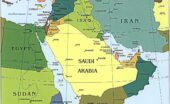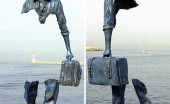Molly Minturn - My family is heartbroken to share that my father died in surgery on Monday, Feb. 10. It…
Russia and the Arctic
Written by Diana Thebaud Nicholson // August 27, 2015 // Arctic and Antarctic, Russia // Comments Off on Russia and the Arctic
“Matching Ambitions and Realities: What Future for Russia?”
(Conference of 6-7 May 2010 organized by CSIS in partnership with Foreign Affairs & International Trade Canada, and the Privy Council Office)
Russia’s Arctic illusions
(Brookings) U.S. chairmanship in the Arctic Council will receive a needed boost from the upcoming conference in Anchorage, which President Barack Obama is due to address on August 31. His message is predictable: He’ll talk about climate change. Russia has received an invitation to the conference, but decided to send a fairly low-level delegation. Russia certainly has important interests in the Arctic region and even higher ambitions, but its Arctic agenda has little to do with climate change. Instead, it can be best described in the old-fashioned and often quite unhelpful terms of geopolitics.
By just about any measure, Russia is an Arctic superpower. It has an enormous coastline, a significant number of people living above the Arctic Circle, six nuclear-powered icebreakers in the region, and industrial centers in Nikel and Norilsk (which produce a high volume of industrial pollution).
Russia used to play up this status, staging large-scale annual conferences, graced by President Vladimir Putin’s presence. Not anymore, and it is not just the fallout from the Ukraine crisis that has poisoned that climate of cooperation. Russia has experienced two major setbacks in its vision for “conquering” the High North.
The first setback came from the seriously reduced value of the natural resources that are presumed to be hidden in the depths of the Arctic shelf. Putin’s lieutenants—including Nikolai Patrushev, the secretary of the Security Council of Russia—loved to engage in speculations about the fierce competition for access to the rich oil and gas fields that were certain to be discovered there. The problem is not only that the U.S. and EU sanctions have made it impossible for the state-owned oil giant Rosneft to continue the exploration of Arctic seas. (Sanctions prevent the import of technology and know-how, and U.S. companies—such as Exxon Mobil—who had worked in partnership with Rosneft have left.) The real problem is that estimated production costs and low oil prices add huge liabilities to any off-shore project.
The second disappointment has to do with international maritime transit along the Northern Sea Route (called Sevmorput in Russian). Many politicians in Moscow expected that climate change would shrink the Arctic ice, increase the commercial viability of a shorter connection between China and Europe, and provide useful employment for Russian icebreakers. The problem is that the old Soviet infrastructure along the Sevmorput is so rotten that navigation in the difficult northern waters remains too risky. Egypt, in the meantime, has swiftly constructed the New Suez Canal, which offers a far more reliable route for tanker and container traffic.
4 August
Russia makes renewed bid for contentious Arctic regions
(BBC) Russia has renewed its efforts to get the United Nations to recognise 1.2 million sq km (463,000 sq miles) of the Arctic shelf that it lays claim to.
It made a similar move for the resource-rich territory in 2001, but that was rejected by a UN commission because of insufficient evidence.
Russia’s foreign ministry said the fresh bid is backed by scientific data.
But all other countries bordering the Arctic – Norway, Denmark, Canada and the US – reject Moscow’s claim.
All five nations have been trying to assert jurisdiction over parts of the Arctic, which is believed to hold up to a quarter of the world’s undiscovered oil and gas.
The competition for Arctic resources has intensified in recent years as the shrinking polar ice opens new opportunities for exploration.
27 July
Russia sees Arctic as naval priority in new doctrine
Russia will strengthen its naval forces in the Arctic and Atlantic as a response to Nato activities close to Russia’s borders, the Kremlin says.
Russia’s plans are outlined in a new naval doctrine, launched on Sunday as the nation celebrated Navy Day.
The navy will get a fleet of new icebreakers, because the Arctic region gives Russia unrestricted access to the Atlantic and Pacific, Russian Deputy Prime Minister Dmitry Rogozin said.
The new doctrine calls for close co-operation with China in the Pacific region and India in the Indian Ocean.
2014
31 October
Russia lays claim to billions of tons of Arctic oil and gas
Vladimir Putin confirms application to extend shelf complete as military bolsters presence in region
(The Telegraph) Moscow has long seen the seabed off its northern coastline as a mine of valuable hydrocarbons and is keen to fend off rival bids for control over the region’s resources.
Sergei Donskoy, minister for natural resources, said Russia had completed research on its submission to the UN, under which it hopes to gain an extra 1.2 million square km (460,000 square miles).
“That is a big increase to the country’s territory, that’s why we call this application an application for the future – an application for the future sustainable development of our country,” said Mr Donskoy after greeting scientists returning home this week from the Arctic to St Petersburg on the Akademik Fedorov research ship.
Mr Donskoy said Russia’s application – which could net it at least five billion tons of hitherto unexploited oil and gas reserves – would be submitted to the UN in the spring. …
Canada also calls the Lomonosov ridge its own and is expected to lay claim to the North Pole itself in a forthcoming application to the UN. Ottawa sent two icebreakers to map a portion of the sea bed around the ridge in August. Denmark thinks the ridge is part of Greenland.
The UN only verifies scientific data and the Arctic countries will be obliged themselves to reach agreements on dividing territory.
25 April

Why Neo-Containment Should Not Extend to Arctic
Robert Murray and Tom Keating
Robert W. Murray is the Vice-President, Research at the Frontier Centre for Public Policy and an Adjunct Professor of Political Science at the University of Alberta. Tom Keating is a Professor of Political Science at the University of Alberta.
(OpenCanada) Russian interests in the Arctic are not primarily about a global competition for power through territorial expansion (despite the indirect implications of power accumulation); it is about pressing territorial and resource claims to their most extreme limits. At the same time, every other Arctic state is pressing similar claims. While military power is not insignificant in asserting and defending such claims, it has not been the exclusive, nor even primary, means employed thus far. Diplomatic and institutional measures are still a viable option for resolving these territorial disputes. A NATO presence in the Arctic would severely undermine these non-military measures and would likely provoke Russia into a game of brinkmanship.
To date, Arctic relations have been entirely diplomatic, with no genuine hint of armed conflict on the immediate horizon. It is true that Arctic states have invested significant domestic resources into Arctic scientific exploration, resource extraction technology and military assets but thus far relations in the Arctic Region have been cooperative. For the first time since the crisis in Ukraine began, though, the Arctic became a component of a broader strategic discussion when Canada withdrew from the meeting of the Arctic Council’s task force on black carbon and methane held in Moscow. Even so, it is likely that Canada’s withdrawal from the proceedings had more to do with the fact that the meeting was being held in Moscow and not a sincere effort on Canada’s part to goad Russia on policy issues concerning the Arctic. …
Canada’s resistance to a NATO presence thus far has been far more about protecting its national interests than anything else, but in this instance Canada would be wise to maintain its stance against NATO involvement. Balancing Russia in the Arctic is more about U.S. interests than Canada’s and committing NATO member states uninterested in armed conflict in the Arctic to a hardline stance is utterly nonsensical. The goal should be to contain Russia in Europe and let the Arctic remain a space for mutual cooperation for as long as possible.
22 April
Russia to Build Network of Modern Naval Bases in Arctic – Putin
(RIA Novosti) – Russia will build a unified network of naval facilities on its Arctic territories to host advanced warships and submarines as part of a plan to boost protection of the country’s interests and borders in the region, President Vladimir Putin said Tuesday.
“We need to strengthen our military infrastructure. In particular, to create in our part of the Arctic a unified network of naval facilities for new-generation ships and submarines,” the president said at a meeting of Russia’s Security Council.
He said that Russia should boost security at its Arctic borders.
Putin ordered the military in December to boost its presence in the Arctic and complete the development of military infrastructure in the region in 2014.
The Defense Ministry has already announced plans to reopen airfields and ports on the New Siberian Islands and the Franz Josef Land archipelago, as well as at least seven airstrips on the continental part of the Arctic Circle that were mothballed in 1993.
The military is also planning to form a new strategic military command in the Arctic, dubbed the Northern Fleet-Unified Strategic Command, by the end of 2014.
2013
10 November
Construction of World’s Largest Nuclear-Powered Icebreaker Begins
Barents Observer is reporting that construction of the world’s largest and most powerful nuclear-powered icebreaker has begun at the Baltic Shipyard in St.Petersburg.
Russia’s yet-unnamed vessel will be powered by two nuclear reactors, and it will be 173 meters long and 34 meters wide. … The new icebreaker, which will be ready for operations in 2017 and will make it possible to use the Northern Sea Route all year around, it added.
11 July
Russia oil and gas: On the cutting edge
(Economist Intelligence Unit) Despite the many risks it holds, the Yamal Peninsula [in Russia’s far-flung Arctic north-west] will be the site of the biggest development of Arctic oil and gas this decade.
Although mainly a natural-gas domain, there is oil in the Yamal Peninsula as well. One field, Novoportovskoye, which Gazprom says has 1.6bn barrels of extractable oil, is due to begin production in 2015.
Still, tapping the region’s vast resources will mean overcoming many difficulties. Among the physical barriers is Yamal’s climate. Winter temperatures drop as low as minus 50 degrees Celsius, bringing a covering of snow and ice that makes drilling technically challenging. It will also be costly and entail environmental risks.
10 March
LUKoil Eyes Arctic Oil
(Moscow Times) Russia’s second-largest oil company will push for legislation to allow independent producers to compete for the right to tap the rich energy reserves of the Arctic. LUKoil President Vagit Alekperov says the company is anxious to get a piece of the Russian Arctic shelf, which is dotted by oil deposits.
2012
24 August
‘The Black Plague’ Russia Plays Game of Arctic Roulette in Oil Exploration
(Spiegel) Thawing sea ice and improved technology is opening up the race for natural resource exploration in the Arctic Circle, home to nearly a quarter of the world’s untapped oil reserves. Russia leads the race and has promised to adhere to environmental guidelines. But accidents and other damage resulting from the country’s oil exploration tell a different story.
2011
4 August
Russia Says High Ice Melt Opens Arctic Trade Routes
(Planet Ark) Arctic ice cover receded to near record lows this summer, opening elusive northern trade routes from Asia to the West, Russia’s climate research agency said on Wednesday.
After the third hottest year on record since 1936 in the Arctic last year, ice cover has melted as much as 56 percent more than average across northern shipping routes, making navigation in the perilous waters “very easy,” it said.
“Since the beginning of August icebreaker-free sailing is open on almost all the routes,” the climate monitoring agency said on its website
It added that the mild conditions would last through September on shipping lanes that are tens of thousands of kilometers shorter than southern alternatives.
With retreating ice opening new strategic trade routes, Russia hopes to make Arctic passage a competitor to the Suez Canal, profiting from taxes and the lease of its unique nuclear icebreaker fleet to escort cargo ships along its Siberian coast.
2010
24 September
Putin’s Environmental Action Plan for the Far North
For decades, Moscow ignored environmental degradation above the Arctic Circle. But this week, Russian Prime Minister Vladimir Putin announced a massive cleanup effort — and plans to increase the exploitation of resources in the region.
Nowhere, is the Arctic as populated as it is in Russia. And nowhere is there as much industrial activity — and resulting pollution. The worst sites are well known. Like, for example, the double island of Novaya Zemlya which was used for a total of 130 atomic weapons tests between 1955 and 1990. In addition, reactors from Soviet-era nuclear submarines were simply scuttled in the Barents Sea and Kara Sea. And then there are the more than 100,000 fuel barrels that the military has left to rot away on the islands of the Franz Josef Land archipelago.
But in addition to the largest sites, there are the numerous mini-environmental transgressions in the numerous Arctic settlements that have been severely neglected or fallen into disrepair since the end of the Soviet Union.
Already, there are some projects underway aimed at cleaning up environmental hotspots, such as that focused pollution associated with nickel smelters on the Kola Peninsula. But for the moment, officials don’t even have a clear overview of what needs to be done. Before the year is up, though, Emergencies Minister Sergei Shoigu plans to put together an atlas of environmental hazards based upon the preliminary work of environmentalists.
22 September
Battle over seabed begins as Arctic Forum gets underway in Moscow
A two-day Arctic Forum has begun in Moscow to try to prevent the North Pole becoming the latest battleground over mineral wealth
Canada, Denmark, Norway, Russia and the United States, whose coasts lie close to the Arctic Circle, are all seeking to assert jurisdiction over parts of the Arctic seabed and are competing over how to divide it up.
17 August 2008
Russia’s Arctic ambitions challenged
With rich oil and gas reserves at stake as the Arctic ice thins, US and Canadian ships are teaming up to conduct a seismic survey of the Beaufort seabed north of the Yukon-Alaska border
16 August
Russia leads scramble for Arctic
(The Telegraph) With the polar icecaps melting, and oil prices at record highs, a scramble for the Arctic’s resources is underway that will transform this forgotten backwater. And Russia is leading the charge, as it signalled last year when a submarine sailed two and a half miles beneath the Polar icecap to the north of Spitsbergen and planted a titanium flag on the seabed.
… – while the planting of the titanium flag was a largely symbolic gesture, it signalled Russia’s intention to claim a vast of territory underneath the icecap that amouts to half the Arctic Ocean’s seabed. If they have their way they will tame one of the last true frontiers, making Moscow the master of much of the Earth’s remaining energy supplies. The risk, however, is of lurching into confrontation with the other polar powers, who are only now waking up to what is at stake. The great prize is the 25 per cent of the Earth’s remaining oil and gas which the Arctic is thought to contain.
… Cleo Paskal, an Assistant Fellow (sic) at Chatham House and an expert on how climate change will affect borders, said: “The Russians have a big head start. Their nuclear submarines have been all over the Arctic for decades, they have 16 icebreaking ships to the Americans’ four, they have a lot of experience and a lot of the right gear.
“And they have a lot to gain. Apart from fossil fuels, there are important fisheries that will increasingly move north with global warming. Strategic control of the Arctic is within their reach.”
July 23
Arctic has 90bn barrels of crude
(FT) The Arctic holds as much as 90bn barrels of undiscovered oil and has as much undiscovered gas as all the reserves known to exist in Russia, US government scientists have said in the first governmental assessment of the region’s resources.
The report is likely to add impetus to the race among polar nations, such as Russia, the US, Denmark, Norway and Canada, for control of the region.
March 8, 2008
Last Dash North
Russia and the Arctic: The New Great Game
Dr Mark A Smith & Keir Giles
Key Points
*
The belief that the North Pole region could contain large
quantities of oil and gas is one of the major forces driving
Russian policy. The North Pole expedition of July-August 2007 is
laying the ground for submitting a claim to the UN Commission
on the Limits of the Continental Shelf that the Lomonosov Ridge
belongs to Russia.
*
Russia’s claims will be challenged by Canada, the USA and
Denmark. The Arctic region is likely to become a region of
geopolitical competition later in the 21st
century as the ice cap melts.
*
There is a widespread view in Russia that its claim to
Arctic territory is not speculative, but rightful compensation for
territorial losses in Europe.
*
Any foreign interest in the area, government, commercial
or environmental, is seen as hostile intent.
*
Armed action by NATO to contest Russia’s Arctic claims is
discussed as a serious possibility.
*
Reports of the death of the Russian North are greatly
exaggerated, as they take no account of commercial rebirth
based on the oil industry.
*
Russia has a well-developed commercial and transport
infrastructure to take advantage of opportunities offered by the
retreating icecap, in contrast to other littoral states.
*
Naval re-armament and increased military activity mean
the same applies to capacity for military action.
Who possesses the Arctic, possesses the entire world.
At a meeting of the State Council in Murmansk in May 2007, Vladimir Putin proposed setting up a National Arctic Council to coordinate national policy and strengthen Russia’s interests in the Arctic region.
In August 2007 the Regional Development Minister Vladimir Yakovlev issued instructions for the creation of an interdepartmental working group to deal with the development of the Arctic zone.
These moves are indicative of a serious and growing Russian interest in the Arctic.
Vladimir Putin has described the north as Russia’s strategic reserve in the development of its statehood.
Russia’s northern regions are an important source of natural resources. In June 2007, the commander of the Northern Fleet, Admiral Vladimir Vysotskiy, noted that Russia obtained 90 per cent of her gas, 60 per cent of her oil, more than 90 per cent of her nickel and cobalt, about 60 per cent of her copper and 98 per cent of her platinum metals from her Arctic regions.
8 per cent of the population live in the Russian North, and they produce about 20 per cent of the national income and account for two-thirds of hard currency earnings.
Russian interest in the Arctic became more pronounced in 2007, with the statement by Russian geologists in June 2007 that the Lomonosov ridge, an underwater shelf in the Arctic Ocean, was linked to the Russian Federation. On 21 June, Duma deputy speaker Artur Chilingarov said that Russia intended to stand up for its lawful rights to the Arctic Ocean shelf.
In July 2007, as part of the Arctic-2007 expedition, a mini-submarine containing two Duma deputies, Artur Chilingarov and Vladimir Gruzdev travelled to the North Pole and placed a titanium Russian flag directly on the pole. Three years earlier, FSB Director Nikolay Patrushev had flown to the North Pole and placed the Russian flag there. The Arctic-2007 expedition’s aim was to make a symbolic claim to the pole and large portions of Arctic territory for Russia.
If Russian claims are ever realised, then Russia would control about 460,000 square miles, an area about the size of western Europe, which would be about half of the Arctic seabed. The United States Geological Survey World Petroleum Assessment 2000 estimated that 25 per cent of the world’s undiscovered oil and gas reserves could lie under the Arctic Ocean.
31 July 2007
As icecaps melt, Russia races for Arctic’s resources
This week, it stakes territory in an internationally administered area said to contain vast oil and gas reserves.
In the next few days, two manned minisubs will be launched through a hole blasted in the polar ice to scour the ocean floor nearly three miles below. They will gather rock samples and plant a titanium Russian flag to symbolize Moscow’s claim over 460,000 square miles of hitherto international territory – an area bigger than France and Germany combined in a region estimated to contain a quarter of the world’s undiscovered oil and gas reserves.
The issue of who owns the North Pole, now administered by the International Seabed Authority, has long been regarded as academic since the entire region is locked in year-round impenetrable ice. But with global warming thinning the icecaps, the question has vaulted to the front burner.



